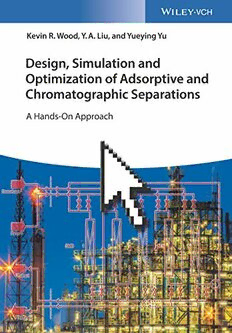Table Of ContentDesign,Simulation,andOptimization
ofAdsorptiveandChromatographic
Separations
Design, Simulation, and Optimization
of Adsorptive and Chromatographic
Separations
AHands-OnApproach
KevinR.Wood,Y.A.Liu,andYueyingYu
Authors AllbookspublishedbyWiley-VCHare
carefullyproduced.Nevertheless,authors,
Dr.KevinR.Wood editors,andpublisherdonotwarrantthe
VirginiaPolytechInstituteandState informationcontainedinthesebooks,
University includingthisbook,tobefreeoferrors.
DepartmentofChemicalEngineering Readersareadvisedtokeepinmindthat
635PricesForkRoad statements,data,illustrations,procedural
245GoodwinHall detailsorotheritemsmayinadvertently
BlacksburgVA24061 beinaccurate.
UnitedStates
LibraryofCongressCardNo.:appliedfor
Prof.Y.A.Liu
VirginiaPolytechnicInstituteandState BritishLibraryCataloguing-in-Publication
University Data
DepartmentofChemicalEngineering Acataloguerecordforthisbookisavail-
635PricesForkRoad ablefromtheBritishLibrary.
245GoodwinHall
BlacksburgVA24061 Bibliographicinformationpublishedby
UnitedStates theDeutscheNationalbibliothek
TheDeutscheNationalbibliothek
Dr.YueyingYu liststhispublicationintheDeutsche
VirginiaPolytechInstituteandState Nationalbibliografie;detailed
University bibliographicdataareavailableonthe
DepartmentofChemicalEngineering Internetat<http://dnb.d-nb.de>.
635PricesForkRoad
245GoodwinHall
©2018Wiley-VCHVerlagGmbH&Co.
BlacksburgVA24061
KGaA,Boschstr.12,69469Weinheim,
UnitedStates
Germany
Allrightsreserved(includingthoseof
translationintootherlanguages).Nopart
ofthisbookmaybereproducedinany
form–byphotoprinting,microfilm,or
anyothermeans–nortransmittedor
translatedintoamachinelanguage
withoutwrittenpermissionfromthe
publishers.Registerednames,trademarks,
etc.usedinthisbook,evenwhennot
specificallymarkedassuch,arenottobe
consideredunprotectedbylaw.
PrintISBN:978-3-527-34469-7
ePDFISBN:978-3-527-81499-2
ePubISBN:978-3-527-81501-2
MobiISBN:978-3-527-81500-5
oBookISBN:978-3-527-81502-9
CoverDesign SchulzGrafik-Design,
Fußgönheim,Germany
Typesetting SPiGlobal,Chennai,India
PrintingandBinding
Printedonacid-freepaper
10987654321
v
Contents
ForewordbyGeorgeE.Keller,II xi
Preface xiii
SoftwareSelectionandCopyrightNotice xvii
Acknowledgments xix
AbouttheAuthors xxi
ListofComputerFiles xxiii
1 SimulationofAdsorptionProcesses 1
1.1 IntroductiontoGas-phaseAdsorptionTechnologies 1
1.2 CoreConceptsinGasAdsorption 2
1.2.1 TheAdsorptionProcess 2
1.2.2 HowtheDrivingForcesAchieveSeparation 3
1.3 Isotherms 4
1.3.1 TheLangmuirIsotherm(1918) 5
1.3.2 TheLinearIsotherm 5
1.3.3 TheBrunauer–Emmett–Teller(BET)Isotherm(1938) 5
1.3.4 TheFreundlichIsotherm(1906) 6
1.3.5 TheSips(Langmuir–Freundlich)Isotherm(1948) 6
1.3.6 TheTothIsotherm(1971) 6
1.3.7 Summary 6
1.4 ThePropertiesofPackedBeds 6
1.4.1 VoidFractions 7
1.4.2 ExternalVoids 8
1.4.3 InternalVoids 8
1.4.4 Densities 8
1.4.4.1 BulkDensity 8
1.4.4.2 SkeletalorSolidDensity 9
1.4.4.3 EnvelopeorParticleDensity 10
1.4.4.4 Caveats 10
1.4.5 Relationships 10
1.4.6 Gas-phaseBehavior 10
1.4.6.1 PressureDrop 10
1.4.6.2 Compressibility 11
vi Contents
1.5 PSAandTSAImplementationDetails 12
1.5.1 CommonAdsorbentCharacteristics 12
1.5.2 CommonProcessConfigurations 12
1.6 IntroductiontoAspenAdsorption 13
1.7 PSAWorkshop:AspenAdsorptionModelingforAirSeparation 15
1.7.1 AddingComponentstoanAspenAdsorptionSimulation 17
1.7.2 CreatingaFlowsheetinAspenAdsorption 22
1.7.3 SpecifyingOperatingConditions:TablesandForms 33
1.7.4 SchedulingEventswiththeCycleOrganizer 42
1.7.5 RunninganAspenSimulation 51
1.7.6 ViewingandExportingSimulationResults 51
1.8 PSAWorkshop:HydrogenSeparationinAspenAdsorption 57
1.8.1 DefinetheComponentsandPropertyModel 58
1.8.2 CreatingaFlowsheetinAspenAdsorption 63
1.8.3 RunaBreakthroughSimulation 65
1.8.4 CreatethePSAFlowsheet 77
1.9 PSAWorkshop:ModelingHydrogenSeparationusinggCSS 87
1.9.1 DefinetheComponentsandPropertyModels 91
1.9.2 WorkingwithModelLibraries:AdvancedFlowsheetOptions 95
1.9.3 IntroductiontoScripting:SetRepeatedValuesandInitialize
Blocks 108
1.9.4 InspectingBlocks:AdvancedOperatingConditions 112
1.9.5 DefiningtheCycleOrganizer 119
1.9.6 ViewingResults 127
1.10 TSAWorkshop:TemperatureSwingAdsorptionforAirDrying 128
1.11 Conclusions 140
1.12 PracticeProblems 143
1.12.1 Introducingagas_interactionUnitintoWorkshop1 143
1.12.2 NaphthaUpgradingUsingAdsorption 145
1.13 Nomenclature 149
Bibliography 150
2 SimulationofSMBChromatographicProcesses 155
2.1 IntroductiontoChromatography 155
2.1.1 MathematicalDifferencesfromGasAdsorption 155
2.1.1.1 TheTraceLiquidAssumption 155
2.1.1.2 ConcentrationVersusPartialPressure 156
2.1.2 ThermodynamicDifferencesfromGasAdsorption 156
2.1.2.1 Isotherms 156
2.1.2.2 PhysicalPropertyModels 156
2.2 IntroductiontoSMBChromatography 156
2.3 SMBImplementationDetails 157
2.3.1 CommonProcessConfigurations 157
2.3.2 M-Values 160
2.3.3 Scale-UpConcerns 161
2.3.4 PressureDropLimitations 162
2.3.5 IntroductiontoOperationalModes 163
Contents vii
2.4 SMBWorkshop:SimulateaFour-ZoneSMBinAspen
ChromatographyfortheSeparationofTröger’sBase
Enantiomers 163
2.4.1 CreatingaFlowsheetinAspenChromatography 163
2.4.2 AddingComponentstoanAspenChromatographySimulation 164
2.4.3 TheChrom_CCC_separator2Block 165
2.4.4 ViewingResults 188
2.5 TandemSMBWorkshop:SimulateaSeparationwithDualSMB
Columns 192
2.6 PracticeProblems 194
2.6.1 RunWorkshop2.4asaSteady-StateSimulation 194
2.6.2 SimulationofanIndustrial-ScaleXyleneSeparationUsingLiterature
Data 200
2.6.3 SimulateaFive-ZoneSMBSystemforSeparatingPhenylalanine,
Tryptophan,andMethionine 202
Bibliography 206
3 ShortcutDesignofSMBSystems 213
3.1 GeneralConcepts 213
3.1.1 MassBalances 215
3.1.2 DifferentialEquations 217
3.1.3 TheMethodofCharacteristics 218
3.2 TriangleTheory 219
3.2.1 Notations 219
3.2.2 Introduction 219
3.2.3 ConstraintsontheSystem 222
3.3 TriangleTheoryWorkshop:DesignofaSystemfortheSeparationof
AminoAcids 224
3.4 Exercise1:CalculatingTransitionsinaFixedBedUsing
Mathematica 230
3.4.1 DifferentialEquations–Analysis 232
3.4.2 ConstructingtheSolutionfromEigenvectorsandEigenvalues 238
3.4.3 UsetheSteady-StateInformationtoConstrainOperating
Conditions 239
3.4.4 CalculatetheCurvesDefinedbytheEigenvectors 241
3.4.5 CalculatetheEigenvaluesalongtheTransition 244
3.4.6 CalculatetheConcentrationsinTimeandSpace 246
3.4.7 AccountforShockWaves 246
3.5 Exercise2:ConstructingtheConstraintsontheTMBSystem
inMathematica 249
3.6 StandingWaveDesign 253
3.6.1 StandingWaveDesigninaNonlinearIdealSystem 254
3.6.2 StandingWaveDesigninaSystemwithNonlinearIsothermand
SignificantMassTransferEffects 261
3.7 StandingWaveDesignWorkshop:CalculatingtheOperating
ConditionsforanIdealandaNonidealSystem 265
3.8 Conclusions 271
viii Contents
3.9 PracticeProblems 272
3.9.1 UsetheTriangleTheoryToolandtheStandingWaveDesignToolto
CreateanAspenSimulationoftheSeparationof1-phenol-1-propanol
onTribenzoate 272
Bibliography 274
4 OperationalModesofSMBProcesses 283
4.1 Overview 283
4.2 SelectionofOperationalModes 284
4.3 Varicol 284
4.3.1 DesignHeuristicsandExamples 286
4.3.2 Workshop1:ApplyVaricoltothe4-ZoneSMBModel 287
4.4 PowerFeed 293
4.4.1 DesignHeuristicsandExamples 294
4.4.2 Workshop2:ApplyPowerFeedtotheFour-ZoneSMBModel 297
4.5 ModiCon 309
4.5.1 DesignHeuristicsandExamples 309
4.5.2 Workshop3:ApplyModiContothe4-ZoneSMBModel 315
4.6 CombinedModes 323
4.6.1 Workshop4:ExtendPreviouslyCreatedFlowsheets 323
4.7 ParallelTwoZones 330
4.7.1 IntroductiontoParallelTwoZones 330
4.7.2 SpecificationAnalysis 334
4.7.3 ImportingFlowsheets 337
4.8 Conclusions 345
4.9 PracticeProblems 345
4.9.1 SimulationofaFive-ZoneSMBUnitUsingtheModiConOperational
Mode 345
4.9.2 CompareParallelTwo-ZoneResultswithSMBResults 345
Bibliography 347
5 ParameterEstimation,Regression,andSensitivityof
AdsorptiveandChromatographicProcesses 349
5.1 EmpiricalCorrelationsforPhysicalProperties 349
5.1.1 AxialDispersionCoefficient 349
5.1.2 MassTransferCoefficient 350
5.1.3 Caveats 351
5.2 ParameterWorkshop:RegressingagainstSteady-State
Experiments 351
5.2.1 Introductionto"Experiments"InAspenSoftware 351
5.2.2 ExperimentalData 352
5.2.3 ParameterRegressioninExcel 352
5.2.4 ParameterRegressioninAspenChromatography 363
5.2.4.1 DefininganEstimationFlowsheet 363
5.2.4.2 EnteringExperimentalData 364
5.2.4.3 EstimationSettings 368
5.2.4.4 RunninganEstimation 370
Contents ix
5.2.5 ParameterRegressionInMathematica 370
5.2.5.1 DefiningtheFunctions 371
5.2.5.2 EnteringtheData 372
5.2.5.3 Regression 375
5.3 ParameterWorkshop:RegressingAgainstDynamicExperiments 376
5.3.1 ProblemDescription 376
5.3.2 DynamicEstimationSettings 376
5.3.3 PerformanceConcerns 380
5.4 XyleneParameterRegression 380
5.5 Conclusions 386
5.6 PracticeProblems 387
5.6.1 PerformDynamicParameterEstimationinAspenAdsorption 387
5.6.2 SensitivityAnalysisUsingScriptsinAspenAdsorption 389
Bibliography 393
LiteratureCitedintheText 395
Index 399

